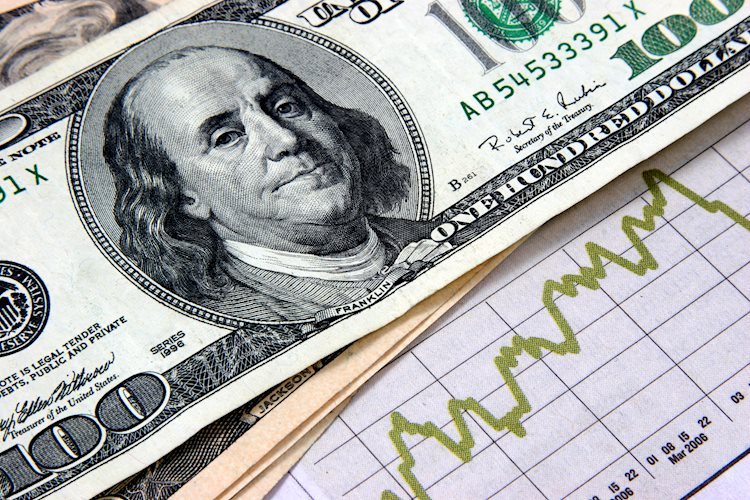- The US Dollar trades flat and is unphased by headlines out of China about ramping up bond sales next year.
- Chinese policymakers plan to sell a record 3 trillion yuan of special treasury bonds in 2025, the highest on record.
- The US Dollar Index (DXY) resides above 108.00, very close to eke out a fresh two-year high.
The US Dollar (USD) trades with small gains on Tuesday, seeing the DXY Index trade slightly above 108.00, as markets are starting to unwind towards the Christmas holiday. The Greenback failed to significantly move despite news that China’s policymakers are floating the idea of selling nearly 3 trillion Yuan (CNH) in special treasury bonds in 2025, Reuters reported on Tuesday. The additional capital should boost the slowing and sluggish Chinese economy.
The US economic calendar is a very light one on Tuesday, with just minor indicators such as the Philadelphia Fed Non-Manufacturing Activity Index and the Richmond Fed Manufacturing Index regional surveys for December. One main takeaway for the last few data points of December is that the US manufacturing sector is sounding the alarm bell, with several indicators confirming the sector is falling further into contraction.
Daily digest market movers: No moves expected
- Policymakers in China plan to sell a record 3 trillion Yuan ($411 billion) of special treasury bonds in 2025, Reuters reported Tuesday. The government seeks to support consumption subsidies, business equipment upgrades as well as investments in key technology and advanced manufacturing sectors, according to Reuters.
- French Prime Minister Francois Bayrou aims to reach an agreement with parliament on a 2025 budget that would reduce the deficit to close to 5%, near the level of his predecessor Michel Barnier, Bloomberg reports.
- Near 13:30 GMT, the Philadelphia Fed Non-Manufacturing Activity Index for December is published. The previous reading stood at -5.9.
- At 15:00 GMT, The Richmond Fed Manufacturing Index is expected to stay in contraction at -9 coming from -14.
- Asian equities are fired up after the 3 trillion Yuan expected injection from China. Europe is rather struggling to benefit from that tailwind and remains looking sluggish. US futures are marginally in the green.
- The CME FedWatch Tool for the first Fed meeting of 2025 on January 29 sees a 91.4% chance for a stable policy rate against a small 8.6% chance for a 25 basis points rate cut.
- The US 10-year benchmark rate trades at 4.59%, the high of last week.
US Dollar Index Technical Analysis: No alarms and no surprises
The US Dollar Index (DXY) is trading in a rather narrow range this Tuesday. More and more traders will not participate in markets today, which will mean nearly no reaction in prices unless a big headline comes up. It thus looks like the DXY is set to close off Christmas eve very close to a two-year high.
On the upside, a trend line originating from December 28, 2023, is acting as a moving cap. The next firm resistance comes in at 109.29, which was the peak of July 14, 2022, and has a good track record as a pivotal level. Once that level is surpassed, the 110.00 round level comes into play.
The first downside barrier comes in at 107.35, which has now turned from resistance into support. The second level that might be able to halt any selling pressure is 106.52. From there, even 105.53 could come under consideration while the 55-day Simple Moving Average (SMA) at 105.23 is making its way up to that level.
US Dollar Index: Daily Chart
Risk sentiment FAQs
In the world of financial jargon the two widely used terms “risk-on” and “risk off” refer to the level of risk that investors are willing to stomach during the period referenced. In a “risk-on” market, investors are optimistic about the future and more willing to buy risky assets. In a “risk-off” market investors start to ‘play it safe’ because they are worried about the future, and therefore buy less risky assets that are more certain of bringing a return, even if it is relatively modest.
Typically, during periods of “risk-on”, stock markets will rise, most commodities – except Gold – will also gain in value, since they benefit from a positive growth outlook. The currencies of nations that are heavy commodity exporters strengthen because of increased demand, and Cryptocurrencies rise. In a “risk-off” market, Bonds go up – especially major government Bonds – Gold shines, and safe-haven currencies such as the Japanese Yen, Swiss Franc and US Dollar all benefit.
The Australian Dollar (AUD), the Canadian Dollar (CAD), the New Zealand Dollar (NZD) and minor FX like the Ruble (RUB) and the South African Rand (ZAR), all tend to rise in markets that are “risk-on”. This is because the economies of these currencies are heavily reliant on commodity exports for growth, and commodities tend to rise in price during risk-on periods. This is because investors foresee greater demand for raw materials in the future due to heightened economic activity.
The major currencies that tend to rise during periods of “risk-off” are the US Dollar (USD), the Japanese Yen (JPY) and the Swiss Franc (CHF). The US Dollar, because it is the world’s reserve currency, and because in times of crisis investors buy US government debt, which is seen as safe because the largest economy in the world is unlikely to default. The Yen, from increased demand for Japanese government bonds, because a high proportion are held by domestic investors who are unlikely to dump them – even in a crisis. The Swiss Franc, because strict Swiss banking laws offer investors enhanced capital protection.


